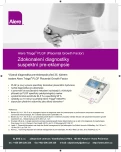Role of fatty acids in sperm membrane
Authors:
X. Štramová 1; Radek Hampl 2; J. Štěpán 2; R. Kanďár 1
Authors‘ workplace:
Fakulta chemicko-technologická, Katedra biologických a biochemických věd, Univerzita Pardubice
Published in:
Ceska Gynekol 2014; 79(2): 103-106
Overview
One of causes of male infertility is reduced sperm motility. Reactive oxygen species (ROS) play significant role for physiological sperm function. Oxidative stress occurs when the production of potentially destructive ROS exceeds the natural antioxidant defences, resulting in cell damage. Sperm phospholipid polyunsaturated fatty acids are particularly susceptible to peroxidative damage by free radicals. Detrimental effects of lipid peroxidation should decrease sperm quality and be responsible of fertility problems.
The review deals with sperm membrane composition, importance of fatty acids and prevention possibilities of oxidative cell damage.
Keywords:
sperm membrane, fatty acids, lipoperoxidation, infertility, antioxidants
Sources
1. Agarwal, A., Prabakaran, SA., Said, TM. Prevention of oxidative stress injury to sperm. J Androl, 2005, 26, p. 654–660.
2. Aksoy, Y., Aksoy, H., Alttinkaynak, K., et al. Sperm fatty acid composition in subfertile men. Prostaglandins Leukot Essent Fatty Acids, 2006, 75, p. 75–79.
3. Bansal, AK., Bilaspuri, GS. Impacts of oxidative stress and antioxidants on semen functions. Vet Med Int, 2011, p. 1–7.
4. Buffone, MG., Doncel, GF., Clalamera, JC., Verstraeten, SV.Capacitation-associated changes in membrane fluidity in asthenozoospermic human spermatozoa. Int J Androl, 2008, 32, p. 360–375.
5. Comhaire, FH., Mahmoud, A. The role of food supplements in the treatment of the infertile man. Reprod BioMed Online, 2003, 7, p. 385–391.
6. Conquer, JA., Martin, JB., Tummon, I., et al. Effect of DHA supplementation on DHA status and sperm motility in asthenozoospermic males. Lipids, 2000, 35, p. 149–154.
7. Conquer, JA., Martin, JB., Tummon, I., et al. Fatty acids analysis of blood serum, seminal plasma, and spermatozoa of mormozoospermic vs. asthenozoospermic males. Lipids, 1999, 34, p. 793–799.
8. Devasagayam, TPA., Boloor, KK., Ramasarma, T. Methods for estimating lipid peroxidation: An analysis of merits and demerits. Indian J Biochem Biophys, 2003, 40, p. 300–308.
9. Gulaya, NM, Margitich, VM., Govseeva, NM., Klimashev-sky, VM. Phospholipid composition of human sperm and seminal plasma in relation to sperm fertility. Arch Androl, 2001, 46, p. 169–175.
10. Henkel, RR. Leukocytes and oxidative stress: dilemma for sperm function and male infertility. Asian J Androl, 2011, 13, p. 43–52.
11. Khosrowbeygi, A., Zarghami, N., Farzadi, L. Fatty acid composition in normozoospermic, asthenozoospermic, asthenoteratozoospermic and oligoasthenoteratozoospermic ejaculates. Iran J Reprod Med, 2008, 6, p. 39–43.
12. Khosrowbeygi, A., Zarghami, N. Levels of oxidative stress biomarkers in seminal plasma and their relationship with seminal parameters. BMC Clin Pathol, 2007, 7, p. 1–6.
13. Kothari, S., Thompson, A., Agarwal, A., du Plessis, SS. Free radicals: their beneficial and detrimental effects on sperm function. Indian J Exper Biol, 2010, 48, p. 425–435.
14. Lenzi, A., Picardo, M., Gandini, L., Dondero, F. Lipids of the sperm plasma membrane: From polyunsaturated fatty acids considered as markers of sperm function to possible scavenger therapy. Hum Reprod Update, 1996, 2, p. 246–256.
15. Maneesh, M., Jayalekshmi, H. Role of reactive oxygen species and antioxidants on pathology of male reproduction. Indian J Clin Biochem, 2006, 21, p. 80–89.
16. Marinelli, D., Gaspari, L., Pedotti, P., Taioli, E. Mini-review of studies on the effect of smoking and drinking habits on semen parameters. Int J Hyg Health, 2004, 207, p. 185–192.
17. Martínez, P., Morros, A. Membrane lipid dynamics during human sperm capacitation. Front Biosci, 1996, 1, p. 103–117.
18. Ollero, M., Powers, RD., Alvarez, JG. Variation of docosahexaenoic acid content in subsets of human spermatozoa at different stages of maturation: implications for sperm lipoperoxidative damage. Mol Reprod Dev, 2000, 55, p. 326–334.
19. Safarinejad, MR., Hosseini, SY., Dadkhah, F., Asgari, AM. Relationship of omega-3 and omega-6 fatty acids with semen characteristics, and anti-oxidant status seminal plasma: A comparison between fertile and infertile men. Clin Nutr, 2010, 29, p. 100–105.
20. Sanocka, D., Kurpisz, M. Reactive oxygen species and sperm cells. Reprod Biol Endocrinol, 2004, 2, p. 1–7.
21. Shiva, M., Gautam AK., Verma, Y., et al. Association between sperm quality, oxidative stress, and seminal antioxidant activity. Clin Biochem, 2011, 44, p. 319–324.
22. Sikka, SC., Rajasekaran, M., Hellstrom, WJG. Role of oxidative stress and antioxidants in male infertility. J Androl, 1995, 16, p. 464–468.
23. Storey, BT. Biochemistry of the induction and prevention of lipoperoxidative damage in human spermatozoa. Mol Hum Reprod, 1997, 3, p. 203–213.
24. Suleiman, SA., Ali, ME., Zaki, ZMS., et al. Lipid peroxidation and human sperm motility. Protective role of vitamin E. J Androl, 1996, 17, p. 530–537.
25. Tavilani, H. Relationship between seminal antioxidant enzymes and the phospholipid and fatty acid composition of spermatozoa. Reprod Biomed Online, 2008, 16, p. 649–656.
26. Tavilani, H., Doosti, M., Abdi, K., et al. Decreased polyunsaturated and increased saturated fatty acid concentration in spermatozoa from asthenozoospermic males as compared with normozoospermic males. Andrologia, 2006, 38, p. 173–178.
27. Tavilani, H., Doosti, M., Nourmohammadi, I., et al. Lipid composition of spermatozoa in normozoospermic and asthenozoospermic males. Prostaglandins Leukot Essent Fatty Acids, 2007, 77, p. 45–50.
28. Tremellen, K. Oxidative stress and male infertility – a clinical perspective. Hum Reprod Update, 2008, 14, p. 248–258.
29. Zalata, AA., Christophe, AB., Depuydt, CE., et al. The fatty acid composition of phospholipids of spermatozoa from infertile patients. Mol Hum Reprod, 1998, 4, p. 111–118.
30. Žák, A., Tvrzická, E., Zeman, M., Vecka, M. Patofyziologie a klinický význam vícenenasycených mastných kyselin řady n-3. Čas Lék čes, 2005, 144, s. 6–18.
Labels
Paediatric gynaecology Gynaecology and obstetrics Reproduction medicineArticle was published in
Czech Gynaecology

2014 Issue 2
Most read in this issue
- Role of prebioptic and bioptic methodsin the screening and diagnosis of cervical cancer
- Intrauterine fetal death syndrom: analysis of cases from 2008 to 2012 in Institute for the care of mother and child
- New views on the functional morphology of human clitoris
- Breech presentation – an analysis of resultsin one perinatal center
